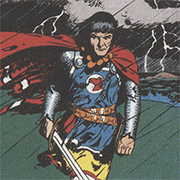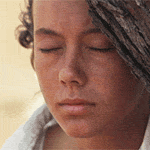|
Elukka posted:I usually start thinking about what's it for and who made it. I might have a loose visual idea at this point, or I might not. For that ship the extent of the latter was "I want it to have a pointy nose". Then I think about what kind of hardware it needs to do what it's for. In my case I like to go with semi-realistic engineering concerns, but you can do the same with entirely fictional tech (like Star Trek did - entirely fictional parts and design rules for ships) or with a more intuitive ruleset. Homeworld is a great example of the latter. In any case, having context and restrictions is very important to me to have any compelling visual ideas. I want to have some narrative context for why the thing exists and I want to have rules for how things work inside the fiction. I like worldbuilding so that comes naturally to me. as someone who does sci-fi modelling occasionally (though admittedly a much lower detail and more stylized I see stuff like this and wish I knew blender instead of 3ds max. the idea of just casually painting on normal maps instead of painstakingly modelling everything while trying to stay under a certain self imposed triangle limit is extremely foreign to me e: in a past life I was a dev on an MMO-esque mod for a long-forgotten space shooter game and a few years ago I had bad nostalgia and started developing parts of an engine for that type of game before I realized what an impossible task that I had given myself and gave up. my fondest memories of it are of relaxing and modelling spaceships and station parts and stuff Kazinsal fucked around with this message at 11:07 on Oct 3, 2021 |
|
|
|

|
| # ? May 25, 2024 00:05 |
|
Kazinsal posted:as someone who does sci-fi modelling occasionally (though admittedly a much lower detail and more stylized I see stuff like this and wish I knew blender instead of 3ds max. the idea of just casually painting on normal maps instead of painstakingly modelling everything while trying to stay under a certain self imposed triangle limit is extremely foreign to me I looked around for software that can do the same and it's either too simplistic or incredibly enormous so I probably have to go for the latter. What NDO does is let you just draw as normal, and what you draw is converted on the fly to normal map, and you have a bunch of sliders to adjust just how that happens for each layer. (depth of the detail, whether it goes up or down, how smooth it is, etc.) e: This is all stuff I just drew in Photoshop and for this kind of thing I find it so much easier than modeling all this detail. Of course, actual modeled detail on a high poly model would still look better... If I was making game models though this would make a whole lot of sense. 
Elukka fucked around with this message at 13:53 on Oct 3, 2021 |
|
|
|
Substance Painter is great for normal mapping and such but again, it's Adobe. If you can stand making a deal with the devil for it I've found it to be a lifesaver for me, since manually photoshopping and texturing stuff is massively outside my wheelhouse.
|
|
|
|
Komojo posted:Bťzier curves are polynomial functions, and the smoothness of the curve depends on the degree of the polynomial. yo this owns. blender thread is the best thread
|
|
|
|
yeah that looks like those curve analysis things sagebrush posts
|
|
|
|
I think I have my default Blender file set up with a collection called "Main" so you might need to change that name to get it to work.
|
|
|
|
I am slowly honing my default blender file to be the one ultimate default file. itís getting very very good now also just came across this and drat if this isnít some inspiration 
|
|
|
|
echinopsis posted:I am slowly honing my default blender file to be the one ultimate default file. itís getting very very good now   Started with a 32 slice cylinder with no cap. Scrolled up a ring cut until the vertical slices had good proportions. Decimate modifier set to un-subdivide, 1 pass to turn the squares into diamonds. Poke faces to get the points on the knurling. Select similar to select all the points, s+shift z to scale them out on the x and y axis. Extruded the top and bottom, subdivided without smoothing. Selected each ring individually and shift alt s to sphere-ify. Bevel on the top, tiny, tiny bevel modifier for a pinch of realism. Light with an environmental texture. Switch to cycles. Go to world and unselect camera under ray visibility to hide the texture. Edit: Oh yeah, and you need shade smooth and autosmooth for the top and bottom. That's the model anyhow. Could spend more time on the shader but Bluemillion fucked around with this message at 23:53 on Oct 3, 2021 |
|
|
|
mate thatís good. youíve got a better feel for the array of mesh editing functions than I do. back when I was doing this model  I really wanted knurled knobs but could never make them 
|
|
|
|
echinopsis posted:mate thatís good. youíve got a better feel for the array of mesh editing functions than I do. Well, now you can! The real meat of that breakdown is the decimate modifier set to unsubdivide and 1 pass, followed by the poke faces. That's all you really gotta remember. Also don't be afraid to search for how to do specific things. I've spent a lot of my life watching youtube tutorials. I insist on doing as much as possible without external add-ons, so I spend a lot of time obsessing over topology and the nitty-gritty of mesh editing. Your shaders and sims are super cool, so keep at it! Bluemillion fucked around with this message at 23:26 on Oct 3, 2021 |
|
|
|
alright lol so I upgraded from a gtx 1060 to an rtx 3060ti I ran a benchmark. 50 samples so not exactly ideal but whatever GTX 1060 6gb cuda: 46s optix: 29s that alone was interesting, that optix on a non rtx card would make such a difference. should have been doing that from ages ago now: RTX 3060Ti cuda: 20s optix..? THREE SECONDS lol Bluemillion posted:I insist on doing as much as possible without external add-ons, so I spend a lot of time obsessing over topology and the nitty-gritty of mesh editing. thanks dude between all of us, we're quite good
|
|
|
|
congrats on the upgrade echi , feels like living in the future doesnít it?
|
|
|
|
I wasnít really unhappy with what I had, not sure what started the bug to get a new one. upgraded my power supply too coz iíd be running at close to hundred percent and imagine thatís not great the ryzen and rtx seem to play together very nicely
|
|
|
|
another benchmark. same scene. 50 samples this is all with rtx cycles (not cycles x) cuda: 30s optix : 24s cycles x cuda 10s optix 5s I have a feeling the prior benchmark I not only switched cards but loaded different blender and switch from cycles to cycles x cycles x with optix is basically insane. the loading kernels sucks tho lol
|
|
|
|
 I left this for an hour it's.... smooth lol
|
|
|
|
thats fkin beautiful how does ray/path tracing simulate subsurface scattering (or any volume scattering really) ? Is there some sort of pre-processing you can do on a volume and do some sort of analytical thing? Or do you basically just have to sample a whole load of randomly bouncing around rays?
|
|
|
|
toiletbrush posted:thats fkin beautiful presumably the latter, it is to some extent the point of raytracing that you just simulate the rays for most light phenomena, including refracting and scattering rays inside materials
|
|
|
|
I think just statistically, as in, the density of a volume is a bit like the chance a ray will scatter/absorb over its step size. butÖ idk, and that doesnít explain much To be clear, I used a volume scatter in that. the surface shader is ordinary shader mixed close to 50/50 with transparent shader the sub surface scattering part of the regular shader is a hack and it works ok but is more of an effect than really representing scattering within a thing iíve been trying to mess around with something that could act to produce veins or something so that the internal density isnít homogenous. thatís what the cubes were for last time, I wanted it to look like there was something inside. any other interesting thing is that if you change the colour of the scatter to say red, the area that gets the light looks red and the rest ends up looking opposite of red because the red light as already been scattered away. different to say absorbing a shade which doesnít tend to do this.
|
|
|
|
Cybernetic Vermin posted:presumably the latter, it is to some extent the point of raytracing that you just simulate the rays for most light phenomena, including refracting and scattering rays inside materials ray tracing .. is old skool path tracing is where itís at
|
|
|
|
echinopsis posted:ray tracing .. is old skool i refuse to consider path tracing distinct from ray tracing
|
|
|
|
can't believe we got graphics chuds itt
|
|
|
|
the whole shtick of path tracing is to send random rays across the range of directions where rays should have bounced and use that to approximate the sum of all rays contributions at that point (more rays=better approximation=less noise) and I don't think subsurface scattering works differently
|
|
|
|
from last year but holy poo poo https://twitter.com/jonasdichelle/status/1328860954856140801?s=21
|
|
|
|
will nodevember allow full use of geo nodes? or will there be a challenge category to only use shader nodes like just starting with the base cube is one
|
|
|
|
Zlodo posted:the whole shtick of path tracing is to send random rays across the range of directions where rays should have bounced and use that to approximate the sum of all rays contributions at that point (more rays=better approximation=less noise) and I don't think subsurface scattering works differently I just checked the docs and it says certain kinds of sss is true volumetric scattering, with the implication that the other types of sss arenít? I think the reason I have thought itís an effect is because all sss is is volumetric scattering, and yet it doesnít always act like volumetric scattering. Iíve used it before and the results have sometimes been odd if itís less common geometry. as in, the results are different than if you made a volume scatter to be the same. at least that what I remember thinking I could well be wrong 🤷♂️
|
|
|
|
the point of nodevember is just doing things procedurally and not creating things by hand. like no sculpting, no texture painting, no music composition. you can use whatever you want towards that end. geometry nodes, animation nodes, shader nodes, procedural sound software, anything along those lines.
|
|
|
|
Jenny Agutter posted:from last year but holy poo poo Today I learned there's a node limit.
|
|
|
|
https://twitter.com/tessamonash/status/1437268643000164354
|
|
|
|
Jenny Agutter posted:from last year but holy poo poo i think i understand how to do this, conceptually e: the hard part would be drawing all the pictures procedurally. making the cards and moving them around would be relatively easy, but tedious fart simpson fucked around with this message at 13:49 on Oct 9, 2021 |
|
|
|
echinopsis posted:another benchmark. same scene. 50 samples yeah dude i went from 2014 intel cpu rendering to cycles x on a 3060. itís literally 20-50x faster depending on the scene
|
|
|
|
This is absolutely true and when I get stuck in a rut with keyframing I just do this for a bit Sometimes it can actually help not often tho
|
|
|
|
https://hdrmaps.com/freebies/ just another source of freebies goodness
|
|
|
|
hey so one of these hdri that I downloaded, it has an exr file like normal but then a folder fill of ordinary photos. dng file format. and it makes me wonder if this hdri has been generated from a bunch of photos. makes me wonder if using photogrammetry you can make your own hdri files without a mirrorball. in fact this should result in less distortion? anyway. cool idea. gonna investigate
|
|
|
|
i made some stitched 360 degree panoramas back in the day. you take a zillion photos in every direction and run them through some software and it makes a 2:1 equirectangular projection and you stick that in your rendering engine and bob's your uncle. (not my uncle) it would be tricky to get a real HDRI out of this because you'd have to take multiple exposure-bracketed photos at each location and stitch them in somehow. but as long as nothing is moving it should theoretically be possible. and if you don't care about it being a true HDRI, any image will work fine, just crank up the contrast
|
|
|
|
oh yeah true .. meshroom seems to ask about camera data a lot, I wonder if it can calculate exposures or whatnot, and if you just use exposure bracketing and do wide brackets
|
|
|
|
to warm up a bit for nodevember, i went back and redid one of my last years submissions: https://i.imgur.com/jFwjLfV.mp4 since then ive learned a bit more about vector displacement workflows and animation so i was able to improve it a bit: https://i.imgur.com/VTY36Jw.mp4 gosh i cant wait for nodevember 
fart simpson fucked around with this message at 14:24 on Oct 11, 2021 |
|
|
|
echinopsis posted:hey so one of these hdri that I downloaded, it has an exr file like normal thats exactly how they make hdris https://blog.polyhaven.com/how-to-create-high-quality-hdri/ although professional groups, like the forza horizon team has talked about this, use a 3-camera rig with super wide angle lenses so they can get the entire sky in one go
|
|
|
|
fart simpson posted:to warm up a bit for nodevember, i went back and redid one of my last years submissions: ha i'm going to have a hard time keeping up this year. should start practicing too
|
|
|
|
Jenny Agutter posted:ha i'm going to have a hard time keeping up this year. should start practicing too i was most excited about figuring out how to do the grass. the trick i was missing last year was alpha masking different chunks of geometry out, and then using the a vector scale node with the factor set to the alpha mask but slightly bigger. you can then do any displacement stuff you want and plug it into that scale node with the mask plugged into the fac and all the displacement will only affect that specific chunk and leave the rest of the object alone. you can then use the same masks as the fac for color mix or shader mix nodes. last year i was stuck thinking about everything as contiguous single objects, so that grass was just taking a tiny bit of the edge of the cube and stretching it out so there was no real geometry to work with. this time my grass was literally just the bottom face of the cube alpha masked out and only stretched slightly, so there was tons of geometry left in there with which to push up some blades of grass, which was just a voronoi driving both the z axis and the color this video tutorial was what taught me about this alpha/scale trick: https://www.youtube.com/watch?v=aEeBAxjvY8U&t=3s once i figured out that trick then making almost anything became "easy" if not tedious. because you can then just isolate everything you want and work on them as separate components entirely and just add everything up before the end. each alpha mask is done independently, and added. each shader is done independently, and added with mix shader nodes. each displacement is done independently, and vector added together. it's a very slick workflow. like for the remake of my house the node tree looks huge but it was actually pretty easy to make since each section is isolated and i can easily change one part without affecting anything else: 
fart simpson fucked around with this message at 16:06 on Oct 11, 2021 |
|
|
|

|
| # ? May 25, 2024 00:05 |
|
here's another trick i picked up for animation: the #frame is just a frame driver (you taught me that last year, jenny). you plug it onto the map range node and set the from min to the start frame you want to start animating that particular property. from max sets the end frame you want that animation to be done. you map that to 0-1 and plug it into an rgb curve and now you have an animation driver that works, in the case of this image, from frame 16 to frame 40 following the easing function i drew out with that rgb curve. its really neat
|
|
|





























